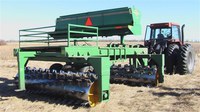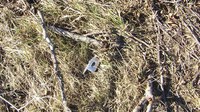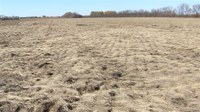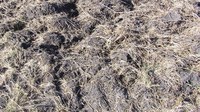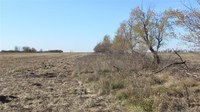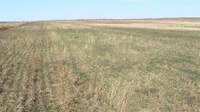Prepare CRP for Crop Production Without Tillage
(Click an image below to view a high-resolution image that can be downloaded)
[Editors: This story is being resent to correct the URL address listed at the bottom of the story.]
Landowners in Eddy County in east-central North Dakota are using an aerator roller to prepare land enrolled in the Conservation Reserve Program (CRP) for crop production. The Eddy County Soil Conservation District purchased the aerator roller this summer, anticipating decisions by landowners to take land out of the CRP program at the end of contract periods and returning the land to crop production or grazing land.
“This machine allows landowners to bring CRP land into production without using conventional tillage equipment that aggressively tills the soil and exposes the soil surface to wind and water erosion,” says John Nowatzki, North Dakota State University Extension Service agricultural machine systems specialist.
The aerator roller is a tandem pasture aerator manufactured by Lawson Manufacturing in Kissimmee, Fla. The machine has 6- by 6- by 1/2-inch angled steel blades mounted in a spiral formation on two 12-foot by 42-inch rollers. The rollers are mounted in tandem, one behind the other, and can be adjusted to operate in five angled positions. The various operating settings change how aggressively the aerator disturbs the soil.
Landowners in Eddy County are using the aerator roller on fields that have been in CRP for the past 10 years to prepare the land for crop production.
“One of the problems encountered by farmers getting CRP land ready for crop production is how to deal with pocket gopher mounds that make the land surface too rough for effective tractor or other equipment operation,” Nowatzki says. “Other issues include standing grasses and surface residue mats from years of growth that have not been removed and volunteer tree and shrub growth.”
The aerator roller sufficiently smoothes the soil surface to allow effective tractor and machinery operation. The blades are mounted on the rollers to cut the standing or matted residue into 10-inch sections, which allows for direct seeding with single-disc, no-till planters.
“Some of the Eddy County fields where the aerator roller was used earlier this fall were planted to winter wheat using a single-disc, no-till planter,” Nowatzki says. “These fields demonstrate the effectiveness of using the aerator roller to get CRP fields into crop production without using aggressive tillage methods.”
The Eddy County Soil Conservation District purchased the aerator roller in June. The district charges $10 per acre if it supplies the tractor, roller and operator. If the farmer supplies the tractor and operates it, the cost is $6 per acre. So far, the aerator roller has been used on approximately 2,000 acres by 15 producers. An additional 15 producers have signed up to use it this fall or next spring.
The roller aerator also is equipped with a planter attachment intended for use to interseed into existing pastureland.
Aerator roller demonstration videos and Internet links to aerator equipment manufacturers are available at http://www.ag.ndsu.nodak.edu/abeng/conservation_tillage/
NDSU Agriculture Communication
| Source: | John Nowatzki, (701) 231-8213, john.nowatzki@ndsu.edu |
|---|---|
| Editor: | Rich Mattern, (701) 231-6136, richard.mattern@ndsu.edu |

